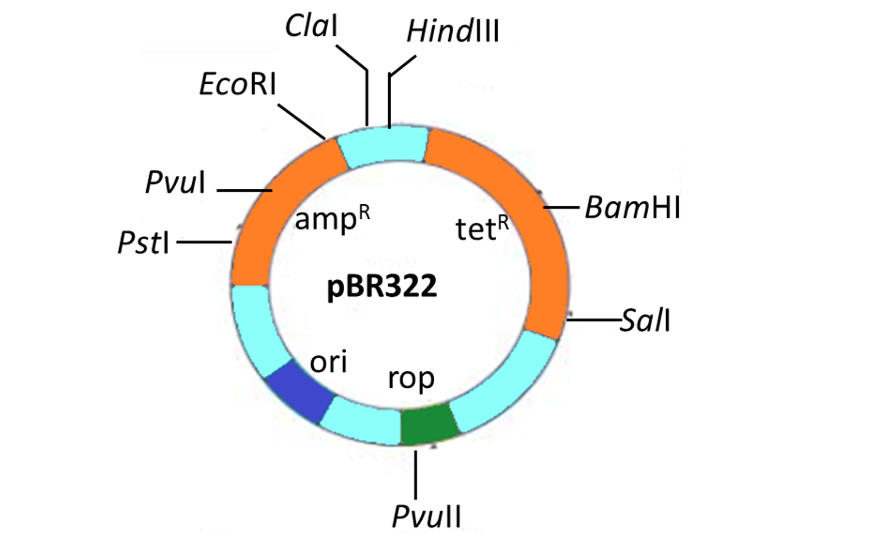
In recombinant DNA methods, the term vector refers to
(a) A DNA probe used to locate a particular gene
(b) A plasmid or other agent used to transfer DNA into a living cell
(c) Enzymes that cut DNA into restriction fragments
(d) Sticky ends or a DNA fragment.
Answer
558.6k+ views
Hint: An extracurricular circular DNA present in the bacteria that is used to transfer foreign DNA into a suitable host and also used to make multiple copies of foreign DNA.
Complete answer:
For the transferring of foreign DNA fragments into a suitable host, a vector is used. If that vector is used to make multiple copies of that transferred DNA it is called a cloning vector. Bacteriophages, plasmids are commonly used vectors. All the bacterial cells contain extrachromosomal DNA that can be easily removed is used as a vector.
Additional Information: - In the DNA hybridization technique, a foreign DNA fragment is inserted to make the desired DNA. This foreign DNA is transferred with the use of vectors. They are also used for making multiple copies of foreign DNA that is transferred into a suitable host. They are called cloning vectors.
- Generally, vectors are taken from the living organisms especially from microorganisms like bacteria. They contain extrachromosomal circular DNA called plasmid which is used as a cloning vector.
- Bacteriophages are the organisms that attack bacteria which can also be used as vectors.
- In cosmids, the cos site of the phage is incorporated into the plasmid.
- In order to cut the desired part of a DNA, various enzymes are used. They are called restriction endonucleases.
So, the correct answer is ‘ a plasmid or other agent used to transfer DNA into a living cell’.
Note: Nowadays artificial vectors also developed the same as plasmids. For example, pBR322 is an artificial vector developed by Bolivar and Rodriguez. The BR in the name is named after these two scientists. Another artificial vector is pUC19,101 developed by the University of California.

Complete answer:
For the transferring of foreign DNA fragments into a suitable host, a vector is used. If that vector is used to make multiple copies of that transferred DNA it is called a cloning vector. Bacteriophages, plasmids are commonly used vectors. All the bacterial cells contain extrachromosomal DNA that can be easily removed is used as a vector.
Additional Information: - In the DNA hybridization technique, a foreign DNA fragment is inserted to make the desired DNA. This foreign DNA is transferred with the use of vectors. They are also used for making multiple copies of foreign DNA that is transferred into a suitable host. They are called cloning vectors.
- Generally, vectors are taken from the living organisms especially from microorganisms like bacteria. They contain extrachromosomal circular DNA called plasmid which is used as a cloning vector.
- Bacteriophages are the organisms that attack bacteria which can also be used as vectors.
- In cosmids, the cos site of the phage is incorporated into the plasmid.
- In order to cut the desired part of a DNA, various enzymes are used. They are called restriction endonucleases.
So, the correct answer is ‘ a plasmid or other agent used to transfer DNA into a living cell’.
Note: Nowadays artificial vectors also developed the same as plasmids. For example, pBR322 is an artificial vector developed by Bolivar and Rodriguez. The BR in the name is named after these two scientists. Another artificial vector is pUC19,101 developed by the University of California.

Recently Updated Pages
Master Class 12 English: Engaging Questions & Answers for Success

Master Class 12 Business Studies: Engaging Questions & Answers for Success

Master Class 12 Economics: Engaging Questions & Answers for Success

Master Class 12 Social Science: Engaging Questions & Answers for Success

Master Class 12 Maths: Engaging Questions & Answers for Success

Master Class 12 Chemistry: Engaging Questions & Answers for Success

Trending doubts
What are the major means of transport Explain each class 12 social science CBSE

Which are the Top 10 Largest Countries of the World?

Draw a labelled sketch of the human eye class 12 physics CBSE

Explain sex determination in humans with line diag class 12 biology CBSE

Explain sex determination in humans with the help of class 12 biology CBSE

Differentiate between homogeneous and heterogeneous class 12 chemistry CBSE




